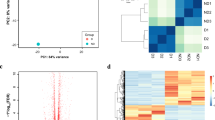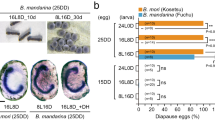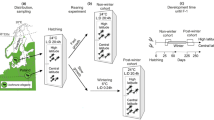Abstract
JUVENILE HORMONE (JH) has been shown to control the synthesis and storage of a diapause-associated protein (DAP) in the larval fat body of the southwestern corn borer, Diatraea grandiosella Dyar1. Our results indicate that DAP is synthesised de novo in pre-diapausing southwestern corn borers, reaches a maximum titre in newly diapaused larvae, and is used gradually during diapause. In addition, we have demonstrated recently that the protein has a molecular weight of about 35,000, and an isoelectric point of about 5.9 (unpublished). Since JH controls the larval diapause of this insect2,3, DAP may be involved in diapause maintenance. Some properties of DAP are described here and the evidence for its function is appraised. Possible functions include a nutritive store of amino acids or peptides, a reservoir of a proenzyme, or a JH-binding protein. From the available evidence, the most likely model is that of a latent store of a high affinity JH-binding protein4–7 which is released and activated during diapause.
This is a preview of subscription content, access via your institution
Access options
Subscribe to this journal
Receive 51 print issues and online access
$199.00 per year
only $3.90 per issue
Buy this article
- Purchase on SpringerLink
- Instant access to full article PDF
Prices may be subject to local taxes which are calculated during checkout
Similar content being viewed by others
References
Brown, J. J. & Chippendale, G. M. Insect Biochem. 8, 359–367 (1978).
Chippendale, G. M. A. Rev. Ent. 22, 121–138 (1977).
Yin, C.-M. & Chippendale, G. M. J. Insect Physiol. 25 (in the press).
Akamatsu, Y. et al. in Control Mechanisms in Development (eds Meints, R. H. & Davies, E.) 123–149 (Plenum, New York, 1975).
Kramer, K. J. & Childs, C. N. Insect Biochem. 7, 397–403 (1977).
Goodman, W., O'Hern, P. A., Zaugg, R. H. & Gilbert, L. I. Molec. cell. Endocr. 11, 225–242 (1978).
Klages, G. & Emmerich, H. Insect Biochem. 9, 23–30 (1979).
Bergot, B. J., Schooley, D. A., Chippendale, G. M. & Yin, C.-M. Life Sci. 18, 811–820 (1976).
Hagedorn, H. H. & Kunkel, J. G. A. Rev. Ent. 24, 475–505 (1979).
Chippendale, G. M. & Yin, C.-M. Nature 246, 511–513 (1973).
Wyatt, G. R. & Pan, M. L. A. Rev. Biochem. 47, 779–817 (1978).
Chippendale, G. M. Ent. exp. Appl. 16, 395–406 (1973).
Stevenson, E. & Wyatt, G. R. Archs. Biochem. Biophys. 99, 65–71 (1962).
Hayes, D. K., Reynolds, P. S., McGuire, J. U. & Schechter, M. S. J. Econ. Ent. 65, 676–679 (1971).
Nowock, J. & Gilbert, L. I. in Invertebrate Tissue Culture (eds Kurstack, E. & Maramorosh, K.) 203–212 (Academic, New York, 1976).
Ferkovich, S. M., Oberlander, H. & Rutter, R. R. J. Insect Physiol. 23, 297–302 (1977).
Author information
Authors and Affiliations
Rights and permissions
About this article
Cite this article
TURUNEN, S., CHIPPENDALE, G. Possible function of juvenile hormone-dependent protein in larval insect diapause. Nature 280, 836–838 (1979). https://doi.org/10.1038/280836a0
Received:
Accepted:
Issue date:
DOI: https://doi.org/10.1038/280836a0



